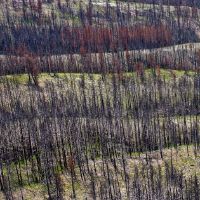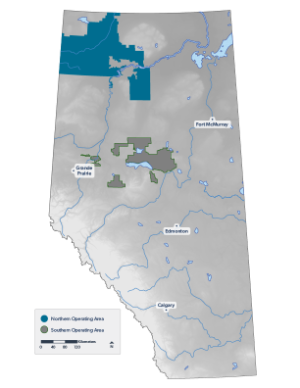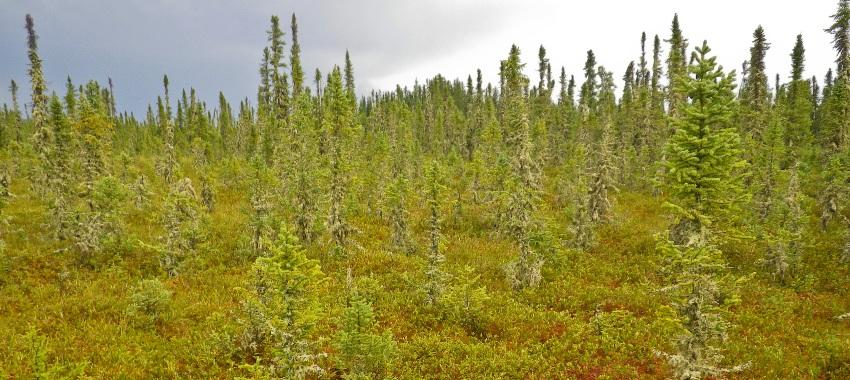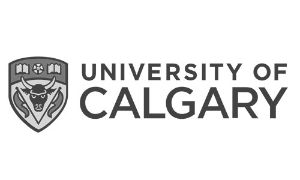Reporting Area and Landscape Context
Description of Tolko's Northern Operating Area, including a summary of the ecosystem and wetland types that compose this landscape.
Tolko's Northern Operating Area covers about 6.5% of Alberta’s land area.
Natural Disturbance

Ecosystem type
Wetlands

Harvesting
Introduction
Tolko’s Northern Operating Area covers 42,771 km2 in northwestern Alberta. This operating area is located entirely within Alberta’s Boreal Forest Natural Region, and is characterized by:
- Vast forested areas of coniferous, mixedwood, and deciduous forests that support a wide range of plants and animals.
- Large numbers of wetlands, meandering streams, and numerous lakes.
- A natural disturbance regime that is dominated by wildfire, with insects and diseases also playing important roles[1].
- Socially and economically valued activities including hunting, fishing, trapping, and other recreational pursuits.
Northern Operating Area
Click on a topic to find out more about Tolko’s Northern Operating Area:
Area of Analysis
Area of Analysis
This report describes the status of land cover and biodiversity in Tolko’s Northern Operating Area.
- The Northern Operating Area is located in the northwestern corner of Alberta and covers 42,771 km2; this makes up 75% of Tolko’s total operating area in Alberta.
- Tolko shares management of this land base with West Fraser Mills Ltd. and La Crete Sawmills Ltd[1].
- In this region, Tolko predominately harvests coniferous species (White Spruce, pine species, Black Spruce, Balsam Fir). Incidental harvest of deciduous trees is passed along to West Fraser Mills Ltd.
Northern Operating Area

Ecosystems
Ecosystems
Tolko’s Northern Operating Area encompasses a diverse range of ecosystem types within the Boreal Forest Natural Region of northern Alberta.
The dominant natural subregions are:
- Central Mixedwood (47.1%),
- Lower Boreal Highlands (23.1%),
- Northern Mixedwood (14.1%), and
- Dry Mixedwood (11.1%).
The Boreal Subarctic (3.4%) and Upper Boreal Highlands (1.3%) cover small areas.
Tolko’s Northern Operating Area contains 6.5% of Alberta’s Dry Mixedwood Natural Subregion, which represents covers 11.1% of the Northern Operating Area. A major portion of the Dry Mixedwood Natural Subregion has been converted to agricultural use, with a variety of annual and forage crops. This subregion is underrepresented in protected areas (federal and provincial parks and protected areas) at 1.6% and, therefore, responsibility for this subregion is higher.
| Northern Operating Area | Alberta | |||
|---|---|---|---|---|
| Natural Region | Natural Subregion | Area (km2) | Area (%) | % Managed as Protected Area |
| Boreal Forest | Central Mixedwood | 20,138 | 47.1 | 13.6% |
| Lower Boreal Highlands | 9,882 | 23.1 | 10.1% | |
| Northern Mixedwood | 6,017 | 14.1 | 44.8% | |
| Dry Mixedwood | 4,735 | 11.1 | 1.6% | |
| Boreal Subarctic | 1,433 | 3.3 | 49.4% | |
| Upper Boreal Highlands | 567 | 1.3 | 25.6% | |
Wetlands
Wetlands
Wetlands are an integral part of the landscape and provide a number of important benefits.
Ecologically intact wetlands, and their associated biodiversity, act as a catalyst for the physical, chemical, and biological processes that:
- provide clean water;
- mitigate flood and drought events;
- recharge ground and surface water;
- capture and store carbon;
- recycle nutrients;
- support a high level of primary productivity; and,
- provide critical wildlife habitat.
Wetlands add habitat complexity at local and regional scales through the creation of micro-habitats, edge effects, and localized microclimates that support a high level of biodiversity, both in the wetland and the surrounding landscape.
Wetlands are common in the Northern Operating Area, covering 36.0% of the land base.
- Fen (also known as muskeg) is the most common wetland class, covering 21.4% of the Northern Operating Area, followed by swamp (5.8%) and bog (4.8%) wetland classes. Marsh and open water wetland classes each cover <2.5% of the area.
- Ecologically significant wetlands in the area include Hay-Zama Lakes—a Ramsar wetland of international importance—as well as several water bodies/watercourses of importance to Trumpeter Swan (a species of special concern in Alberta).
| Wetland Class | Area (km2) | % area |
|---|---|---|
| Bog | 2,049 | 4.8 |
| Fen | 9,143 | 21.4 |
| Marsh | 698 | 1.6 |
| Open water | 1,027 | 2.4 |
| Swamp | 2,489 | 5.8 |
| All Wetlands Combined | 15,406 | 36 |
References
Tolko Industries Ltd., Norbord Inc., and La Crete Sawmills Ltd. 2017. Forest management plan. Forest management plan submitted to Alberta Agriculture and Forestry December 2017 for FMU26. 375 pp.





